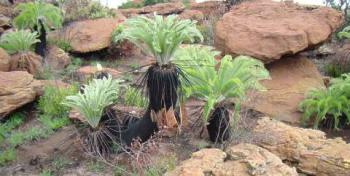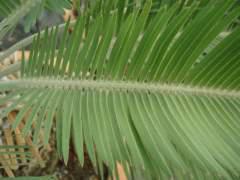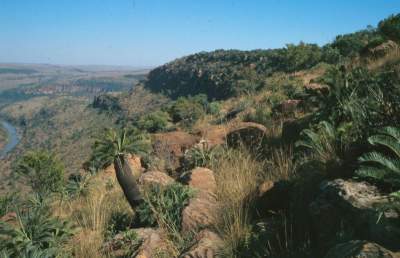Encephalartos lanatus
Encephalartos lanatus Stapf & Burtt Davy
Family: Zamiaceae
Common names: Woolly cycad (Eng.)
SA Tree No: 5.2
Introduction
Encephalartos lanatus is normally a medium-sized, single-stemmed plant about 1–1,5 m high. In the garden, it enjoys a position in full sun and is a strong architectural plant that makes a good focal point. E. lanatus is frost-hardy, fire-adapted and drought-resistant.

Description
Description
E. lanatus is a small, slow-growing tree with stems usually about 1,5 -2,5m long and 25–30 cm in diameter. The young leaves are grey and woolly and have a curved apex.

Mature leaves are greyish green, about 60–80 cm in length.

Both male and female cones are densely woolly when young, and become yellow with age. They are dioecious, i.e. the cones are borne on separate plants. Female cones are barrel-shaped, 25–30 cm long and 12–15 mm in diameter. Male cones are cylindrical, 25–30 cm long and 5–6 cm in diameter. E. lanatus sometimes sends out suckers at the base of the main stem. The mature seeds are yellow and fleshy and smaller than those of other commonly cultivated species such as E. altensteinii.
Conservation Status
Status
E. lanatus is categorised as NT (Near Threatened).
Legislation relating to growing /owning cycads in South Africa
Distribution and habitat
Distribution description
E. lanatus occurs naturally in Gauteng and Mpumalanga in the catchment area of the Olifants River in the Middelburg, Witbank and Bronkhorstspruit districts. This highveld grassland species occurs in sheltered rocky valleys that experience moderately hot summers and very cold frosty winters.

Derivation of name and historical aspects
History
Encephalartos is Greek for 'bread in head and refers to the floury, starchy material in the trunks of some species, which is used as famine food by local native tribes. Lanatus means woolly in Latin, referring to the wool on the young leaves and on the cones. The species is often confused with E. laevifolius, E. humilis and E. friderici-guilielmi.
Ecology
Ecology
Being a grassland species, it is well-adapted to the annual fire season. According to Giddy C. (1984) "... owing to regular fires in the area, new leaves and cones are borne almost every year and this regular, induced coning probably accounts for the heavy plant population of all ages". Most cycad seeds are commonly destroyed by the Curculionid weevil (Antliarhinus zamiae).

Growing Encephalartos lanatus
Grow
E. lanatus is easily grown from seed. Because cycad seeds are toxic to humans one should use gloves when handling or cleaning them.
Hand-pollination is necessary for a successful seed harvest in cultivation. Pollen can be collected as soon as it starts shedding. If a slight tapping of the male cone sheds pollen, then the cone is ready to be harvested. Pollen should be stored at – 15° C for best results. The female cone scales have to be monitored to check when they are open. Individual plants vary in the duration of scale-opening, from three days to two weeks. The wet method, using distilled water in a syringe, has given us at Kirstenbosch a good pollination rate. After female cones have been collected the seed is left to mature for a year before sowing at the beginning of summer.
For best results, seed is sown in river sand on a heated bench at 24–28° C. Germination should start three weeks after sowing. However, some seeds will take longer.
E. lanatus is slow-growing and reported to be very difficult to transplant; plants die easily or take a long time to recover when transplanted. Leaves and cones are prone to scale and mealy bugs. In the spring at Kirstenbosch we apply a mixture of 3. 1. 5, bone-meal and organic fertilizer to each plant. During the year we regularly feed the plant with a generous layer of compost.
References
- Donaldson, J. S (ed.). 2003. Cycads. Status survey and conservation action plan. UCN/SSC Cycad Specialist Group. IUCN, Gland, Switzerland and Cambrige, UK
- Giddy, C. 1974. Cycads of South Africa. Struik, Cape Town.
- Goode, D. 2001. Cycads of Africa. Cycads of Africa Publishers, Gallomanor, South Africa.
- Jones, D.L. 1993. Cycads of the World. Reed Books, Australia.
- Whitelock, L. M. 2002. The Cycads. Timber Press Inc., Portland, Oregon, USA.
Credits
Phakamani M’ Afrika Xaba
Kirstenbosch National Botanical Garden
March 2008
Plant Attributes:
Plant Type: Shrub, Tree
SA Distribution: Gauteng, Mpumalanga
Soil type:
Flowering season:
PH:
Flower colour:
Aspect: Full Sun
Gardening skill: Average
Special Features:
Horticultural zones









Rate this article
Article well written and informative
Rate this plant
Is this an interesting plant?
Login to add your Comment
Back to topNot registered yet? Click here to register.